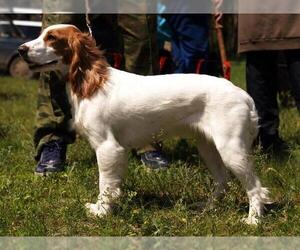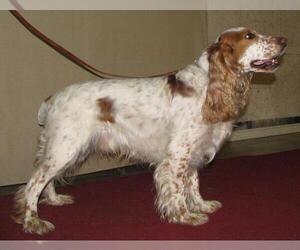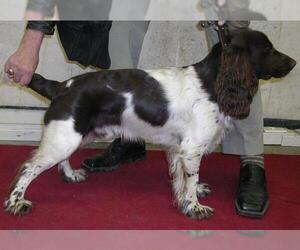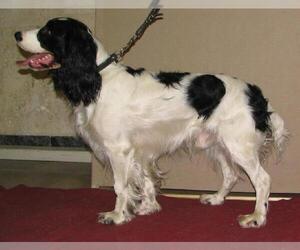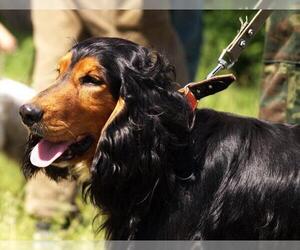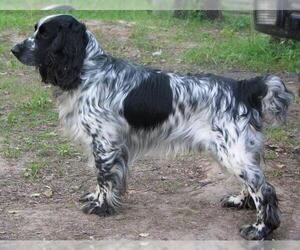
All about Russian Spaniel dog breed
A.K.A. :Russian Hunting Spaniel, Russian Field Spaniel, Spaniel Russe de Chasse, Russischer Jagdspaniel, Russkiy Spaniel, Russian Spaniel Hunting, Russian Black Spaniel
Size
Grooming requirements
Exercise requirements
Good with other dogs
Watchdog ability
Energetic
Training requirements
Playful
Affectionate
Good with other pets
Good with children
Good with strangers
Winter
Summer
Healthiness
Protective
Life Span
| Pure Breeds | Member |
| Breeds A - Z | R |
| Breeds by Group | Gun Dog Sporting |
| Breeds by Trait | Good With Kids High Stamina Dog Breeds Low Shedding |
| Overview: | The Russian Spaniel is a lively and affectionate breed, meticulously developed in Russia during the mid-20th century to be a versatile hunting dog, particularly adept at flushing and retrieving game. Physically, they are medium-sized, well-proportioned dogs with a sturdy build and a distinctive slightly wavy, medium-length coat that comes in a variety of colors, often with ticking or patches. Their expressive, dark eyes and pendulous ears give them an endearing appearance. Temperamentally, they are known for being friendly, intelligent, and eager to please, making them highly trainable. While energetic and requiring regular exercise to prevent boredom, their adaptable nature means they can be suitable for family life and, with sufficient daily activity, can even adjust to apartment living. Generally a healthy breed, potential owners should be aware of a predisposition to common canine ailments such as hip and elbow dysplasia, and ear infections due to their ear structure, emphasizing the importance of responsible breeding and regular veterinary check-ups. |
F.A.Q.
All You Need to Know About the Russian Spaniel Breed
The Russian Spaniel, a medium-sized gun dog, originated in Russia in the mid-20th century, bred from English Cocker, English Springer, and other spaniels to adapt to the country's diverse terrains and harsh climates. They possess a friendly, intelligent, and energetic temperament, making them excellent companions for active families. Physically, they are sturdy, with a distinctive long, wavy coat that comes in various colors, and expressive eyes. While adaptable, their energy levels mean they thrive with a fenced yard and daily exercise, making them less suited for small apartment living unless significant outdoor time is guaranteed. Grooming requirements are moderate, involving regular brushing to prevent matting, especially during shedding seasons. Generally a healthy breed, potential owners should be aware of common canine ailments like hip dysplasia and ear infections, which are typical for spaniel breeds. Their eagerness to please and trainability make the Russian Spaniel a rewarding choice for experienced dog owners and active households.What is the average weight of a Russian Spaniel?The average Russian Spaniel weight is between 28-40 pounds. This is the healthy weight for Russian Spaniel adults. While there isn't a significant difference, males tend to be at the higher end of this range, while females are typically slightly lighter, closer to the 28-35 pound mark. This provides an excellent indication of their average size.
Russian Spaniel Height: What's Their Average Size?
Curious about how tall a Russian Spaniel gets? When considering a new furry friend, understanding their physical dimensions is key, and we're here to help you get a clear picture of the typical Russian Spaniel height.The average adult Russian Spaniel stands between 15 to 17.7 inches (approximately 38 to 45 cm) at the shoulder. This measurement is taken from the ground up to the highest point of their shoulder blades (the withers).While this range gives you a good idea of their general size, it's worth noting that individual dogs can vary. You might find some Russian Spaniels slightly shorter or taller than this average. Generally, male Russian Spaniels tend to be at the higher end of this scale, often being a bit taller and more substantially built than females, though this isn't a strict rule for every individual dog.Factors like genetics, nutrition during their growth phase, and overall health can also influence a Russian Spaniel's final height. So, if you're asking "how tall is a Russian Spaniel?", remember that while there's a standard average, a little variation is perfectly normal for this delightful breed.Russian Spaniel Colors: Accepted & Exotic VariationsThe Russian Spaniel, a charming and active breed, exhibits a variety of beautiful coat colors. When considering Russian Spaniel colors, it's important to understand both commonly seen and officially recognized variations, as well as rarer or exotic types that may not be accepted by major kennel clubs like the AKC (American Kennel Club), which currently does not recognize the Russian Spaniel.Common and Accepted Russian Spaniel Colors:The most prevalent and generally accepted Russian Spaniel coat colors include a range of solids and parti-colors. These are typically recognized by breed clubs in Russia and Europe where the breed is more established.* Solid Black: A sleek and classic appearance.* Solid Brown (Liver): Ranging from a light to a rich, dark chocolate.* Solid Red: Often a deep, warm mahogany or chestnut.* Solid Fawn: A lighter, creamier red or tan.* Black and White (Parti-color): A striking combination of black patches on a white base.* Brown and White (Parti-color): Rich brown patches on a white base, sometimes referred to as liver and white.* Red and White (Parti-color): Red patches on a white base, a vibrant and popular choice.* Orange and White (Parti-color): Lighter orange patches on a white base, similar to red but with a softer hue.* Tri-color: A combination of black, tan, and white, or brown, tan, and white. This typically involves tan points over the eyes, on the cheeks, and under the tail, in addition to the main body color and white.* Roan: A fine mixture of colored hairs with white hairs, creating a mottled effect. This can appear as Blue Roan (black and white mix), Liver Roan (brown and white mix), or Orange Roan (red/orange and white mix).These accepted Russian Spaniel colors are common and reflect the breed's working dog heritage, often providing camouflage in various hunting environments.Rare and Exotic Russian Spaniel Variations:While the above colors are standard, some breeders may occasionally produce exotic Russian Spaniel variations that are not typical for the breed and are generally not desired or recognized by breed standards. These can arise from recessive genes or cross-breeding in some instances. Potential buyers should be aware that these rare coat types may come with different pricing and should research their origin carefully.* Blue: A dilute of black, appearing as a grey or slate color.* Lilac (Isabella): A dilute of liver/brown, presenting as a pale, pinkish-grey or mushroom tone.* Merle: A pattern that creates irregular splotches of dilute color on a solid or parti-colored coat. Merle is generally considered undesirable and can be linked to health issues in some breeds.* Chocolate (Solid Liver): While "brown" is accepted, some breeders may market a deep brown as "chocolate" to emphasize its richness. However, true chocolate (a specific genetic dilute) is less common in the established lines than a standard liver.* White with Colored Patches: While white with colored patches is normal, a predominantly white dog with very minimal color might be considered an extreme variation.It is important to reiterate that the AKC does not currently recognize the Russian Spaniel, so there are no AKC recognized Russian Spaniel colors. For information on official breed standards and acceptable colors, consult the breed clubs in Russia or European countries where the Russian Spaniel is recognized. Pricing for Russian Spaniel puppies will vary based on lineage, health clearances, and demand, with rare or exotic color variations often commanding higher prices, though not necessarily indicating higher quality or adherence to breed standards. Always prioritize health and temperament over coat color.
The Russian Spaniel boasts a delightful and energetic personality, making them wonderful family companions. Known for their cheerful and outgoing nature, their temperament of Russian Spaniel is generally friendly and sociable. They form strong bonds of loyalty with their families and thrive on interaction, making them excellent partners for active households.
They are typically good with children, particularly when raised together or properly socialized, showing patience and a playful spirit. Their inherent sociability usually extends to other pets, and they can coexist peacefully with other dogs and even cats, especially with early introduction. While highly adaptable, their active nature means they require regular exercise and mental stimulation. Despite their moderate size, they can adapt to apartment living provided their exercise needs are met with daily walks and playtime. The Russian Spaniel personality is intelligent and eager to please, making them relatively easy to train with positive reinforcement. They are not typically known for being aggressive and are more inclined to greet strangers with curiosity than suspicion, though they will alert their owners to new arrivals. Overall, they are affectionate, lively, and devoted dogs.Russian Spaniel Temperament: A Loving & Adaptable CompanionThe Russian Spaniel temperament is a delightful blend of affection, intelligence, and a lively spirit, making them an excellent companion dog. They are renowned for their friendly and outgoing nature, readily forming strong bonds with their families.Sociability & Affection: These dogs are highly sociable and thrive on human interaction, displaying immense loyalty and devotion. They are not typically shy or reserved, often greeting strangers with a wagging tail once they've assessed the situation. Their desire to be involved in family activities is strong, and they'll happily follow you from room to room.Adaptability to Apartment Living: While active outdoors, the Russian Spaniel is surprisingly adaptable to apartment living as long as their exercise needs are consistently met. Their moderate size and desire to be close to their owners make them comfortable in smaller spaces, provided they receive daily walks and playtime.Behavior with Children & Other Pets: With proper socialization, Russian Spaniels are generally excellent with children, often displaying patience and a playful demeanor. They can also integrate well with other pets, especially if introduced carefully during puppyhood. Their hunting instinct is present but typically manageable, and they can coexist peacefully with cats or smaller animals with training.Stubbornness & Sensitivity: While intelligent and eager to please, the Russian Spaniel can exhibit a degree of stubbornness, particularly if they don't see the point of a command. This is usually easily overcome with positive reinforcement and consistent training. They are generally not overly sensitive but respond best to gentle, firm guidance rather than harsh corrections. Overall, their personality traits lean towards an enthusiastic, biddable, and loving family member.
Russian Spaniel Care: Your Daily Maintenance GuideHow to care for a Russian Spaniel? Providing proper Russian Spaniel care ensures a happy, healthy companion. This breed is known for being relatively low-maintenance, but consistent attention to key areas is essential.Grooming Needs: Your Russian Spaniel requires moderate grooming. Their silky coat needs weekly brushing to prevent mats and reduce shedding. Occasional bathing (every 1-2 months or as needed) will keep their coat clean and healthy. Pay special attention to the longer feathering on their ears, legs, and tail, as these areas are more prone to tangles. Regular nail trims (every 2-4 weeks) are also crucial.Exercise Limitations: The Russian Spaniel is considered a low-energy dog breed. They are content with moderate daily exercise, such as two 20-30 minute walks or active playtime in a securely fenced yard. While they enjoy outdoor activities, avoid strenuous exercise, especially in hot or humid weather, due to their brachycephalic (short-nosed) anatomy. Their flat faces make them susceptible to overheating and breathing difficulties.Dietary Considerations: Feed a high-quality, balanced diet appropriate for their age, size, and activity level. As they can be prone to weight gain, carefully monitor portion sizes and avoid overfeeding. Consult your veterinarian for specific dietary recommendations and to discuss appropriate treats. Weight management is crucial for preventing joint problems and other health issues.Wrinkle and Ear Cleaning: Due to their facial wrinkles and floppy ears, daily maintenance includes regular cleaning. Gently clean facial folds with a damp cloth to prevent skin irritation and infections. Their long, floppy ears require weekly inspection and cleaning with a vet-approved ear cleaner to prevent ear infections, which are common in breeds with pendulous ears.Climate Sensitivity: Their brachycephalic anatomy makes them sensitive to extreme temperatures. How to care for a Russian Spaniel in different climates involves keeping them indoors during hot or humid weather and providing a cool, well-ventilated environment. During colder months, ensure they have a warm, sheltered place. Never leave them unattended in a car, even on mild days.Common Health Concerns & Health Tips for Russian Spaniel: Be proactive about your Russian Spaniel’s health. Common concerns include skin issues (often related to wrinkles or allergies), dental problems, and ear infections. Regular veterinary check-ups are vital for early detection and prevention. Implement a consistent dental care routine, including brushing their teeth several times a week, to prevent periodontal disease. Monitor for any signs of discomfort or changes in behavior and consult your vet promptly.
Russian Spaniel Activity Level: Moderate with Brachycephalic ConsiderationsThe Russian Spaniel activity level is best described as moderate. These charming dogs possess a balanced energy level, enjoying short bursts of playful activity and longer periods of restful companionship. They are not high-strung but do require consistent daily engagement to stay happy and healthy.Typical Energy Levels and Exercise Needs:Expect your Russian Spaniel to enjoy daily walks, typically 30-60 minutes in total, broken into two or three outings. They thrive on mental stimulation as much as physical, so incorporate playtime with toys, scent games, and basic obedience training into their routine. While they appreciate a good run in a secure area, they are equally content with a leisurely stroll through the neighborhood, sniffing and exploring.Playtime Preferences:Russian Spaniels love to play! They enjoy fetch, tug-of-war, and interactive toys. Their natural retrieving instincts make them enthusiastic participants in games involving balls or soft toys. They are also known for their affectionate nature and will happily engage in cuddle sessions on the sofa after their exercise.Limitations Due to Brachycephalic Anatomy:It's crucial to understand the brachycephalic (short-nosed) limitations of the Russian Spaniel. Their unique facial structure means they are prone to overheating, especially in warm weather or during strenuous exercise. Always prioritize their comfort and safety. Avoid exercising them during the hottest parts of the day. If they show any signs of labored breathing, excessive panting, or lethargy, stop exercise immediately and seek a cool, shaded area. Due to these limitations, they are not ideal candidates for prolonged, intense activities like long-distance running or agility competitions that demand continuous high output.Balancing Energy and Rest:Russian Spaniels beautifully balance short bursts of energy with long periods of rest. They will happily zoom around the yard for 15-20 minutes, then settle down for a nap at your feet. This makes them adaptable companions for various lifestyles.Suitability for Families:Are Russian Spaniels suitable for active families or low-energy households? They can thrive in both, with appropriate adjustments. An active family can enjoy their playful nature during moderate activities, ensuring they are not overexerted. A low-energy household can provide the necessary daily walks and mental enrichment without feeling overwhelmed by a dog with endless energy. Their adaptable nature and loving disposition make them wonderful family pets, as long as their unique physical considerations are respected. If you're wondering how active are Russian Spaniel, remember they are a delightful blend of playful spirit and calm companionship, requiring thoughtful exercise management.
To understand how to keep Russian Spaniel healthy, owners should maintain a lean body weight to reduce strain on hips and spine, provide regular but moderate exercise suited to their hunting stamina, and avoid strenuous activity in hot weather. Grooming routines should include brushing to prevent matting and skin irritation, ear cleaning to reduce infection risk, and dental care to prevent periodontal disease. Allergy management may require dietary adjustments or veterinary guidance, while routine veterinary checkups are essential for monitoring orthopedic health, spinal stability, and eye conditions such as cataracts or progressive retinal atrophy (PRA).
In addition to these concerns, Russian Spaniels may inherit breed-specific risks such as epilepsy, hypothyroidism, and congenital eye disorders. Preventive screenings, responsible breeding, and consistent veterinary monitoring are key to minimizing these risks and supporting long-term wellness. With proactive care, adopters and buyers can ensure this loyal, intelligent, and energetic gun dog remains strong, healthy, and happy throughout its life.
Breed Breakdown: What Experts Say About the Russian Spaniel
I would rate the "Size" trait of the Russian Spaniel at a 4.This rating reflects that the Russian Spaniel is a medium-sized dog, leaning towards the smaller end of that spectrum. They typically stand around 15-17 inches tall and weigh between 25-35 pounds. Their body structure is sturdy and athletic, but not bulky. When compared to other companion dogs, they are significantly larger than toy breeds like Chihuahuas (a 1 or 2) but notably smaller than large breeds like Golden Retrievers (a 7 or 8) or Great Danes (a 10). Their compact yet robust build makes them a good fit for apartment living as long as they receive adequate daily exercise. Their manageable size also makes them relatively easy to travel with and they are well-suited for households with moderate space constraints, though a small backyard is always a bonus for their energetic nature.
I'd rate the Russian Spaniel's grooming requirements at a 6 out of 10.While not as demanding as some long-haired breeds, they aren't entirely wash-and-wear. Their medium-length, dense coat, combined with feathering on the legs, chest, and tail, will require regular brushing several times a week to prevent mats and tangles, especially during shedding seasons. They are moderate to heavy U-shedders, meaning you'll see a noticeable amount of hair around the house. Their floppy ears are prone to infections if not cleaned regularly, and like most dogs, their nails will need routine trimming. Occasional bathing is necessary to keep their coat clean, and while generally healthy, their dense coat can make them susceptible to hot spots or other skin irritations if not dried thoroughly after getting wet. Compared to a short-haired breed, they definitely require more consistent attention to their coat, but they don't demand the daily, specialized styling or professional grooming often associated with breeds like Poodles or Shih Tzus.
I would rate the Russian Spaniel's exercise requirements as a 7 out of 10.While not a hyperactive breed like some working or sporting dogs, the Russian Spaniel possesses a strong hunting drive and a need for consistent physical and mental stimulation. They are not dogs that will be content with a short daily walk and then lounging on the couch. Their energy levels are moderate to high, and they thrive on sustained movement. They are known for their endurance and their ability to cover ground in the field, so a simple stroll around the block won't suffice. Daily long walks, vigorous playtime, and opportunities for off-leash running in a secure area are highly recommended. They are agile and intelligent, making them suitable for activities like fetch, exploring new trails, and even some introductory scent work or obedience training that engages their minds as well as their bodies. Although not brachycephalic, their compact and muscular build means they benefit from regular, but not necessarily extreme, cardiovascular activity to maintain a healthy weight and muscle tone. Without structured routines and ample opportunity to burn off energy, they can become bored, destructive, and even develop behavioral issues. They truly thrive when given a purpose and the chance to use their natural instincts, making them a breed that requires a dedicated owner committed to meeting their activity needs.
I would rate the Russian Spaniel's "Watchdog Ability" as a 4 out of 10.While inherently alert and attentive to their surroundings, the Russian Spaniel is primarily bred for hunting and companionship, not for guarding. They are generally friendly and good-natured, extending this amiable disposition to strangers rather than showing suspicion. While they will likely bark at the sound of someone at the door or an unfamiliar noise, this barking is more a notification of "something is happening" rather than an aggressive or territorial warning. Their territorial instincts are low, and their response to unfamiliar people is typically curiosity or a desire for attention, not a deterrent. They lack the inherent drive or assertive nature to actively deter an intruder; they're far more likely to observe from a distance or even approach with a wagging tail. Therefore, they are much more of a passive companion who might provide an early, albeit often unassertive, warning that someone is present, rather than a breed capable of providing meaningful deterrence in a home environment.
I would rate the Russian Spaniel's "Good with Other Dogs" trait as an 8 out of 10.Russian Spaniels are generally known for their good-natured and amiable personalities, which extends to their interactions with other dogs. They were bred as hunting companions, working closely with humans and other dogs in the field, so a natural sociability and lack of aggression towards canine peers is a deeply ingrained trait. They typically exhibit friendly and curious behavior around unfamiliar dogs, often approaching with a wagging tail and an eagerness to play. Their medium size and moderate energy levels make them quite adaptable to dogs of various sizes and energy levels, and they usually adjust well to different play styles.While early socialization is always beneficial for any breed, Russian Spaniels don't typically require extensive or specialized training to coexist peacefully. They generally thrive in canine company and are well-suited for multi-dog households, often forming strong bonds with their housemates. Instances of aggression or dominance are rare and usually stem from poor socialization or individual temperament rather than breed-specific tendencies. They are generally adaptable and enjoy the companionship of other dogs, making them a good choice for owners who already have or plan to have multiple pets.
I would rate the Russian Spaniel's "Energetic" trait as a 7 out of 10.The Russian Spaniel is a naturally active and enthusiastic breed, definitely not laid-back compared to many other companion dogs. They possess a good amount of energy, stemming from their hunting dog heritage, which translates into a strong desire for play and a need for consistent physical stimulation. They thrive on outdoor activities, enjoying walks, runs, and games of fetch, and their endurance is generally good for their size. This breed is quite playful and intelligent, often instigating games and requiring mental engagement alongside their physical exercise.However, their brachycephalic (short-nosed) anatomy does have an impact on their stamina and exercise tolerance, preventing them from reaching the extremely high energy levels seen in some other sporting breeds. While they are energetic and enjoy activity, prolonged, intense exercise, especially in hot weather, can be challenging for them due to their breathing limitations. Owners need to be mindful of this and ensure they don't overexert their Russian Spaniel, making their exercise sessions fun and regular rather than excessively long or strenuous. They need active daily engagement, but not to the extent of a border collie or a Siberian husky.
I'd rate the Russian Spaniel's "Training Requirements" a 6 out of 10.While intelligent and eager to please their owners, Russian Spaniels are also a hunting breed with an independent streak and a strong prey drive. This combination means they are responsive to commands and can learn quickly, but their attention span can be easily diverted by interesting scents or movements. They require consistent, positive reinforcement training from a young age to channel their energy and intelligence effectively. Their occasional stubbornness, especially when their instincts kick in, means training sessions need to be engaging and varied to maintain their focus. This breed is generally not beginner-friendly due to the need for experienced handling and a structured, consistent routine to prevent them from developing undesirable behaviors. Owners must be prepared to invest significant time and effort into their training and socialization to cultivate a well-behaved and adaptable companion.
I'd rate the Russian Spaniel's "Playful" trait a 9 out of 10.Russian Spaniels are naturally spirited and highly energetic dogs. They absolutely adore games and interaction, consistently demonstrating a strong desire for engagement with their humans. You'll find them eagerly responding to toys, often initiating playtime themselves, and exhibiting an infectious enthusiasm in daily life. Their attention-seeking behavior is usually rooted in a desire to play or be involved, and their typical activity level is quite high, needing regular outlets for their boundless energy. They are definitely more on the fun-loving and energetic side compared to many other companion dogs, thriving on active participation and mental stimulation through play.
I would rate the Russian Spaniel's "Affectionate" trait at an 8 out of 10. These dogs are generally very loving and devoted companions, thriving on human interaction. They exhibit a strong desire for human companionship, often following their family members around the house and preferring to be in the same room. While not always overly demanding of physical closeness like some "velcro" breeds, they certainly enjoy a good cuddle session and are known to be lap dogs, especially when relaxed. Their loyalty is unwavering, and they are quite sensitive to their owner's emotions, often offering comfort or mirroring the mood of the household. Compared to many companion dogs, they are definitely on the more affectionate side, though their sporting background means they also appreciate some independent activity and aren't entirely dependent on constant attention, finding a good balance between their love for their people and their energetic nature.
I would rate the "Good with Other Pets" trait of the Russian Spaniel breed an 8 out of 10.The Russian Spaniel is generally a very adaptable and good-natured breed, known for its affectionate and friendly disposition. They tend to be quite sociable and enjoy being part of the family, which often extends to other pets in the household. Their prey drive, while present as a hunting breed, is typically moderate and can be managed with proper training and early socialization, especially when introduced to cats or smaller animals. They are not usually prone to significant resource guarding, particularly if raised with other pets and taught good manners. While naturally sociable, early and consistent socialization with various animals is still crucial to foster their natural inclination to coexist peacefully. With appropriate training and supervision, they are highly adaptable and thrive in multi-pet households, often forming strong bonds with their animal companions.
The Russian Spaniel receives a rating of 8 out of 10 for "Good with Children."This breed is generally known for its gentle and affectionate nature, making them well-suited for families with children. They exhibit a good degree of patience, which is crucial when interacting with younger children who may be less predictable. Their inherent playfulness aligns well with the energy of children, often enjoying games of fetch or other interactive activities. They tend to be tolerant of the typical noise and bustling that comes with a family home, and while supervision is always recommended with any dog and child, the Russian Spaniel generally takes well to gentle handling. While their natural temperament leans towards being child-friendly, like all breeds, early socialization and consistent positive reinforcement training will further enhance their compatibility and ensure they thrive as a loving and well-behaved family member. They are not a breed that typically requires extensive training to overcome aggression or fear around children, but rather to channel their energy and reinforce good manners.
I would rate the Russian Spaniel's "Good with Strangers" trait as a 7 out of 10.The Russian Spaniel is generally a friendly and affable breed, especially when properly socialized from a young age. They are not typically aggressive or overly reserved with unfamiliar adults. Their sporting dog background often means they are adaptable and comfortable in various environments, including public spaces or with guests present, as long as they perceive the situation as non-threatening. They are more likely to greet new people with curiosity and a wagging tail rather than significant suspicion or fear. While they may offer a warning bark if someone approaches their home unexpectedly, they are not typically prone to excessive guarding behavior or being overtly protective in a way that makes them unfriendly. However, like any breed, a lack of early and consistent positive exposure to diverse people can make them a bit more reserved, but their natural inclination is towards being outgoing and welcoming rather than aloof. They are not naturally shy, but strong socialization is key to ensuring their natural friendliness shines through consistently.
I would rate the Russian Spaniel's "winter" tolerance as a 6.While they possess a fairly dense, water-repellent double coat that offers good insulation, they are not a breed built for extreme cold. Their medium size and active nature mean they generate some body heat through movement, but they don't have the substantial fat reserves of a Northern breed. Furthermore, their slightly brachycephalic (though not as extreme as a Bulldog) anatomy can make them more susceptible to respiratory issues in very cold, dry air. They are less prone to immediate hypothermia than a toy breed, but prolonged exposure in freezing temperatures would be a concern, and they would quickly become uncomfortable. They can certainly enjoy outdoor activity in most cold climates, but for extended periods or in sub-zero temperatures, they *would* require special care compared to other companion dogs. This includes ensuring they have warm, dry shelter, potentially wearing a coat for walks, and limiting their time outdoors to prevent discomfort and health risks, particularly for older or very young individuals. They are not a breed you'd leave out in the snow for hours like a Siberian Husky.
I would rate the Russian Spaniel's "Summer" tolerance at a 6. While not brachycephalic, their medium-length double coat can make them susceptible to overheating in hot weather. They are an active breed and enjoy outdoor activities, but strenuous exercise during peak heat should be avoided. They can regulate their body temperature reasonably well, but like all dogs, are at risk of heatstroke if not properly managed in high temperatures. Compared to many companion dogs, they don't require extreme special care beyond common sense precautions for any dog with a double coat: ensuring access to shade and water, avoiding midday walks, and monitoring for signs of overheating. They would benefit from indoor access with climate control during very hot days, but generally don't require constant air conditioning.
I would rate the Russian Spaniel's "Healthiness" trait as an 8 out of 10.This breed is generally considered robust and has a reputation for being quite healthy, especially when compared to many other purebred dogs. They typically have a good life expectancy of 12-14 years. Being a relatively modern breed developed for practical hunting purposes, there has been a strong emphasis on health and working ability in their breeding, rather than extreme conformational traits that can lead to health issues. They are not known for severe breathing difficulties or widespread structural problems like some brachycephalic or giant breeds.While not entirely without potential issues – like any breed, they can be susceptible to common canine ailments such as hip and elbow dysplasia (though generally not as prevalent or severe as in some other spaniels or larger breeds), eye conditions, and ear infections due to their floppy ears (requiring regular cleaning) – these are often manageable with responsible breeding practices, preventive care, and a good diet. They are generally considered low-maintenance in terms of health compared to breeds with more inherent genetic predispositions or extreme physical traits.
I would rate the Russian Spaniel's "Protective" trait at a 5 out of 10.While the Russian Spaniel is an alert and loyal breed, it is primarily a companion dog and a dedicated hunting retriever, not inherently bred for protection. Their alertness will certainly make them good watchdogs, as they are likely to bark to signal the presence of strangers or unusual activity. This territorial barking can be a deterrent to some. They are deeply loyal to their owners and will undoubtedly stand by them, but their reaction to strangers is more likely to be one of cautious curiosity or even an attempt to make friends, rather than aggressive defense. They lack the strong territorial instincts and inherent suspicion of unknown individuals that breeds specifically developed for guarding possess. Therefore, while they'll certainly let you know if someone is approaching, and their presence might be a minor deterrent, they are not capable of offering meaningful physical protection in a household setting against a determined intruder. They are far more suited to being loving family members and excellent hunting partners than guard dogs.
I would rate the Russian Spaniel's "Life Span" trait a 7 out of 10.This breed is generally considered to be of average to slightly above-average longevity compared to other companion dogs. With a typical life expectancy ranging from 12 to 14 years, and many individuals living even longer with good care, they don't fall into the category of exceptionally short-lived breeds. While they can be prone to some common canine ailments like hip and elbow dysplasia, and certain eye conditions, these are largely manageable through responsible breeding practices (screening parents) and proactive veterinary care. They aren't known for a high prevalence of breed-specific, rapidly fatal genetic diseases. Therefore, with proper nutrition, exercise, and veterinary attention, a Russian Spaniel can be expected to live a good, full life.
Russian Spaniel Dogs for adoptionSee all dogs for adoption
Russian Spaniel BreedersSee all breeders
Similar Dog Breeds for Russian Spaniel
Quick Breed Selector 0 - not important, 1 - smallest, 10 - largest
Variants & Mistakes :Russin Spaniel, Rusian Spaniel, Russian Spaneil, Russian Spanie, Russian Spania, Rusion Spaniel, Rushian Spaniel, Russina Spaniel, Russion Spaniel, Russain Spaniel, Russin Spaneil, Rusian Spaneil, Rusian Spanie, Rusian Spania, Russina Spaneil, Russhian Spaniel, Rushan Spaniel, Russsian Spaniel, Russan Spaniel, Russain Spaneil, Rushin Spaniel, Russin Spanie, Russin Spania, Rusain Spaniel, Rusain Spaneil, Rusain Spanie, Rusain Spania, Russhan Spaniel, Russian Spanel, Russian Spaniol, Russian Spannel, Russian Spiniel, Russian Spaniyel, Russian Spanyel, Russian Spaniele, Russian Spaniell, Russian Spanei, Russion Spaneil

